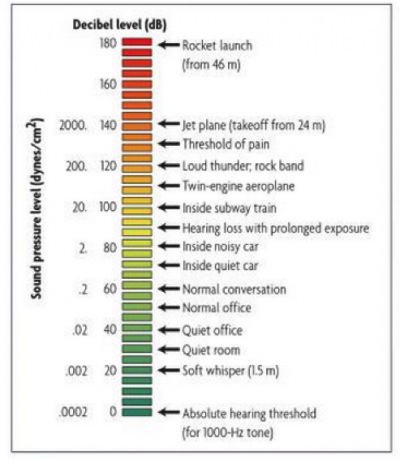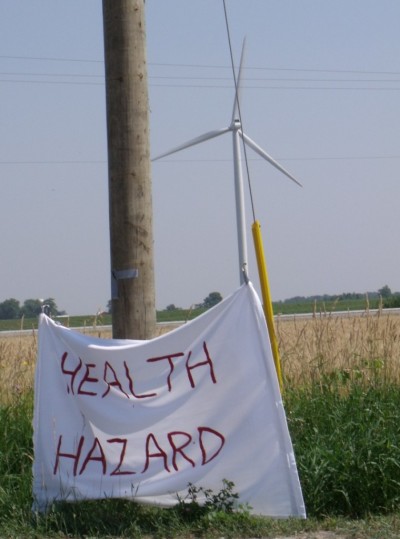 By Anna Tomczak, Department of Health Sciences, Carleton University
By Anna Tomczak, Department of Health Sciences, Carleton University
Although the saying “sleep is for the weak” was a common theme throughout high school and university, sleep has become more of a luxury – something we always want and can never get enough of. This is especially true considering that Canadians’ quality of sleep has been on the decline for the last couple of decades (Canadian Medical Association, 2012). It is no wonder then, that people take their sleep seriously – so when something disrupts their sleep, such as a neighbor’s loud dog, a snoring partner, or perhaps some noise from wind turbines, they get frustrated and may start complaining. Sometimes these complaints are valid; however, at other times they may be pointing a finger in the wrong direction.
The recent increase in wind turbine farms has generated a lot of controversy in communities where they have been built. Many residents are worried over the possible effects the wind turbines will have on their health, including sleep. It is quite evident that noise can disrupt sleep and studies have shown that sleep loss is implicated in several negative health outcomes. A lack of sleep has been shown to increase the risk of obesity, workplace injuries, and is a risk factor for a number of health conditions including stress, cardiovascular disease, and stroke. It is for this reason that the World Health Organization (WHO) has created guidelines for community noise. These guidelines recommend that indoor sound levels should not exceed 30 dBA of continuous noise, and that the outdoor levels of noise should average no more than 40 dBA (WHO, 1999). Effectively, outdoor noise levels should be no higher than noise levels in a quiet office (Figure 1).

Figure 1. Decibel levels of familiar sounds.
Gerrig, R. J., Zimbardo, P. G., Campbell, A. J., Cumming, S. R., & Wilkes, F. J. (2011). Psychology and life. Pearson Higher Education AU
Since wind turbine farms are fairly recent, very few studies have looked at the relationship between wind turbine noise and sleep disturbance. Undertaking studies in the vicinity of wind turbine farms can be challenging given that typically, there are relatively few individuals who live close to them. However, given that wind turbine farms are increasingly common, and anticipated to start producing larger and larger amounts of energy, it is important to study their impacts on our health. The few studies that have looked at the effects that wind turbines had on sleep quality relied on participants to report their own sleeping patterns. These subjective interpretations of sleep may be biased in several important ways. Individuals may not be able to accurately recollect sleeping patterns. For example, individuals with insomnia often report much worse quality of sleep than what actually occurred (Dittoni et al., 2013). Self-reported measures of sleeping patterns may also be influenced by individuals’ perceptions of the impacts that the wind turbines may have on their health. This may be an important source of bias, and several studies have shown that individuals often have a tendency to over-report certain types of outcomes if they are aware and concerned about a nearby potential health hazard. To overcome this bias, studies often try to use both subjective and objective measures of sleep quality to obtain a more accurate estimate of the association between noise and sleep quality. Objective measures of sleep quality are more challenging to obtain as they require the use of monitoring devices. Health Canada recently reported on findings from their epidemiological study examining the impacts of wind turbine noise on a number of health outcomes including sleep quality. To our knowledge it is the only study to report on these associations between wind turbine noise and both subjective and objective measures of sleep.
Assessing Sleep Quality and Wind Turbine Noise
The Health Canada study included a total of 1238 participants, between the ages of 18-79 years, who lived between 0.25 and 11.22 kilometers away from an operational wind turbine in southwestern Ontario and Prince Edward Island. In order to minimize bias stemming from any previous misconceptions residents may have had on wind turbines, the study did not focus on wind turbines alone, and was more broadly referred to as the Community Noise and Health Study. Data collection took place through in-person interviews, during which participants filled out questionnaires on noise annoyance, health effects, quality of life, sleep quality, perceived stress, lifestyle behaviours and prevalence of chronic disease. Participants sleep patterns were measured in two ways. The first, a self-reported method, measured sleep disturbance using a widely used series of questions referred to as the Pittsburgh Sleep Quality Index (PSQI). In order to obtain a longer term measure of sleep quality, participants were asked to describe their level of sleep disturbance over the last year. The second method was objective in nature and used an Actiwatch2™ to measure sleep patterns of a sub-group of participants over a seven night period. This type of device is based on movement and can measure timing and duration of sleep, as well as awakenings. This enables it to provide a more accurate and reliable measure of sleep disruption when compared to self-report measures.
 The study estimated participants exposure to wind turbine noise by placing sound pressure receptors near the wind turbines that were located in their communities. Outdoor sound pressure levels were estimated from receptors located near 315 wind turbines in southwestern Ontario and 84 in PEI. The investigators were then able to estimate the wind turbine noise in the homes of these participants by applying models that took into account the distance between the home and the wind turbine and measured noise.
The study estimated participants exposure to wind turbine noise by placing sound pressure receptors near the wind turbines that were located in their communities. Outdoor sound pressure levels were estimated from receptors located near 315 wind turbines in southwestern Ontario and 84 in PEI. The investigators were then able to estimate the wind turbine noise in the homes of these participants by applying models that took into account the distance between the home and the wind turbine and measured noise.
Is Wind Turbine Noise Too Loud?
Using the receptors found near the wind turbines, the study found that the majority of dwellings fell below the WHO recommended outdoor night time sound pressure levels (40 dB). On this basis, the findings suggest that noise from the wind turbines is unlikely to cause sleep disturbance. The average bedroom noise level among those who indicated they kept their windows open was 32 dB, which is close to the 30 dBA indoor threshold in the WHO’s Guidelines for Community Noise. With windows closed however, indoor wind turbine noise levels remain below 26 dB – low enough to avoid any sleep disturbance. Only 19% of dwellings exceeded the 40 dB limit, reaching a maximum of 46 dB – 6 dB above the recommended annual average nighttime limit.
Does Wind Turbine Noise Affect Our Sleep?
The Health Canada study evaluated the association between wind turbine noise and sleep by using several measures of sleep disturbance. The findings are compelling given that they found no association between wind turbine noise and of the different sleep measures. They did, however, find that sleep quality was affected by a number of other factors.
The first measure of sleep looked at sleep efficiency (having trouble initiating and maintaining sleep) and although it was found to be associated with being male, having less than high school education, being obese and drinking 3-4 cups of coffee a day, no significant associations with exposure to wind turbine noise were observed.
Individuals who were 65+ years of age, obese, or did not have asthma were more likely to take longer to transition from being awake to being asleep (sleep latency). Sleep latency was not associated with wind turbine noise.
As with the other dimensions of sleep, wind turbine noise had no impact on total sleep time. Shorter sleep time was associated with factors such as physical pain, being diagnosed with a sleeping disorder and having a stand-alone air conditioning unit in the bedroom.
Wake time after sleep onset tended to be longer for those who were not employed, had a lower education level, had bedroom located in basement, being a former smoker, and not taking sleep medication at least once a week. Once again, wind turbine noise had no effect on sleep.
The last sleep factor looked at was how often individuals would wake after having fallen asleep. As with total sleep time, the main factors associated with the rate of awakening were physical pain, drinking 3-4 cups of coffee and being single.
So what’s the Problem?
 These findings suggest that the noise created by wind turbines does not have a significant impact on our quality of sleep. However the findings from this study are being met with skepticism. Why is this issue still so controversial? Seeing as research is still relatively new in relation to the health effects of wind turbines, some elements may still not be fully explained. Although this study was one of the first to take into consideration both subjective and objective measures of sleep, it had other limitations. Because it focused on the long-term effects of wind turbine noise on sleep quality, the estimates of wind turbine noise was based on an average generated over a period of time, and was not estimate of noise exposure that occurred on the same night participants’ sleeping characteristics were being measured. Future studies that measure noise exposure and sleep on the same night may yield more clues about subtle impacts that were not detected in this study. The study did, however, find that it is not necessarily the noise but rather was the annoyance with the blinking lights on wind turbines used to signal low flying airplanes, which might affect sleep quality. Either way, the study does suggest that long term measures of wind turbine noise are not related to several measures of sleep quality. However, we are still at an early stage of understanding the impacts that wind turbines might have on our sleeping patterns and overall health. For now though, next time you wake up from a bad sleep, remember that the neighbour’s barking dog is probably more at fault than the wind turbine down the street.
These findings suggest that the noise created by wind turbines does not have a significant impact on our quality of sleep. However the findings from this study are being met with skepticism. Why is this issue still so controversial? Seeing as research is still relatively new in relation to the health effects of wind turbines, some elements may still not be fully explained. Although this study was one of the first to take into consideration both subjective and objective measures of sleep, it had other limitations. Because it focused on the long-term effects of wind turbine noise on sleep quality, the estimates of wind turbine noise was based on an average generated over a period of time, and was not estimate of noise exposure that occurred on the same night participants’ sleeping characteristics were being measured. Future studies that measure noise exposure and sleep on the same night may yield more clues about subtle impacts that were not detected in this study. The study did, however, find that it is not necessarily the noise but rather was the annoyance with the blinking lights on wind turbines used to signal low flying airplanes, which might affect sleep quality. Either way, the study does suggest that long term measures of wind turbine noise are not related to several measures of sleep quality. However, we are still at an early stage of understanding the impacts that wind turbines might have on our sleeping patterns and overall health. For now though, next time you wake up from a bad sleep, remember that the neighbour’s barking dog is probably more at fault than the wind turbine down the street.
Based on:
Michaud, D. et al. (2016). Impacts of wind turbine noise on self-reported and objective measures of sleep. Sleep, 39, 91 – 109. http://dx.doi.org/10.5665/sleep.5326
Note: Several other papers from this Health Canada led study are expected to be published later in 2016, and these papers will focus on various health endpoints.